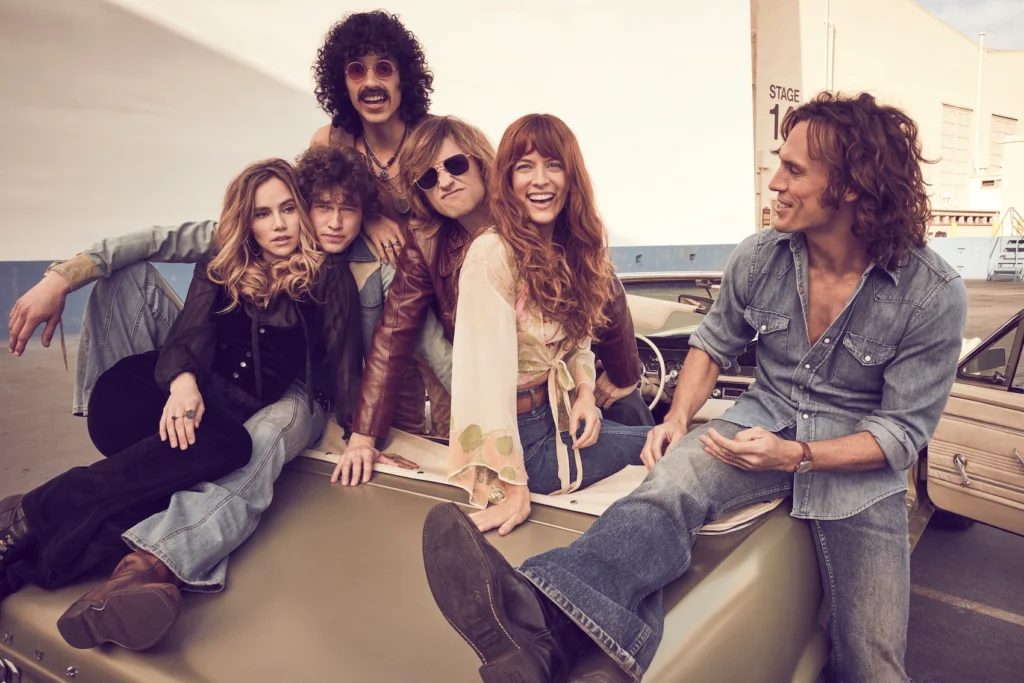“Daisy Jones & The Six” (published in 2019) is a novel by Taylor Jenkins Reid that takes readers on a wild ride through the success of the eponymous band in the 1970s music industry. The book is written in a unique format as if it is a collection of interviews with the band members, their families, and those closest to them a few decades after the band has broken up.
It tells the story of how the band was formed, their meteoric rise to fame, and the personal and professional challenges they faced along the way. At the center of it, all is Daisy Jones, a talented and enigmatic singer whose voice captures the hearts of millions. As she joins forces with The Six, a rock band on the brink of stardom, their collaboration becomes the stuff of legend. But with success comes tension, and as the band reaches the pinnacle of its fame, the tensions boil over into an explosive finale.
“Daisy Jones & The Six” is a thrilling and unforgettable tale of love, betrayal, and rock ‘n’ roll that will leave readers breathless. You can pick up a copy online or at the nearest bookstore or watch the latest series on Amazon Prime based on the novel. In this article, we want to talk about the interview format in which the book is written and how the different narrative perspectives affect storytelling.
The Interviews in Daisy Jones & The Six
In “Daisy Jones & The Six,” several characters are interviewed, including:
- Daisy Jones: The beautiful and enigmatic lead singer of the band
- Billy Dunne: The charismatic frontman and lead guitarist of The Six
- Camila Dunne: Billy’s wife and the mother of his children
- Karen Sirko: The keyboardist of The Six and one of the few female members of the band
- Teddy Price: The bassist of The Six and a former football player
- Graham Dunne: Billy’s younger brother and the drummer of The Six
- Warren Rhodes: The manager of The Six and a music industry veteran
- Eddie Loving: A producer who works with the band
- Simone Jackson: A backup singer who becomes a love interest of Billy
- Pete Loving: Eddie’s brother and a roadie for the band
One of the main challenges posed by a large cast of characters is the risk of confusion and overwhelm for the reader. It can be difficult to keep track of who each character is, how they relate to one another, and their individual motivations and conflicts. This can lead to a lack of engagement with the story and a feeling of detachment from the characters. In Daisy Jones & The Six, Taylor Jenkins Reid does an admirable job of managing a large cast of characters. Each member of the band is distinct and fully developed, with their own backstory and motivations. The novel is structured as an oral narrative, with each character given their own voice and perspective. This allows the reader to engage with each character on a personal level and understand their individual contributions to the band’s rise and fall.
The Band Speaks: The Interviews as a Narrative Device

- Daisy Jones
Daisy Jones is a beautiful, young, and wild woman. She grows up in a privileged household with parents who were not around much and begins her music career at a young age, becoming a well-known figure in the music scene.
Throughout the interviews, we see Daisy’s journey as she tries to balance her desire for fame and her personal life, which includes a string of tumultuous relationships. Her persona during interviews is that of an enigmatic, unpredictable artist who often speaks in vague terms, leaving those around her wondering what she really means. However, as the story progresses, we see glimpses of vulnerability and insecurity beneath the tough exterior she presents to the world.
Despite her flaws, Daisy is a charismatic and captivating performer who draws people to her. As the lead singer of The Six, she becomes a vital part of the band’s success, and her creative contributions help shape their music. Overall, Daisy’s journey in the book highlights a journey of self-discovery and coming to terms with the consequences of her actions. Through her highs and lows, she remains a complex and compelling character whose story leaves a lasting impression.
- Billy Dunne
Billy Dunne is the lead singer and guitarist of The Six. He is initially portrayed as a tortured artist struggling with addiction and the pressures of fame.
During the interviews in the book, Billy is as introspective and deeply affected by the band’s history. He reflects on his struggles with addiction and his relationship with Daisy, which was fraught with tension and ultimately ended in a dramatic fashion. He gets overly affected by his relationship with Daisy, especially when they write their to-be-groundbreaking song “Honeycomb.” The song is inspired by their love for each other, and Billy pours out his heart and soul into the lyrics. However, when the song becomes a hit, Billy realizes that he has inadvertently revealed the intimate details of his relationship with Daisy to the world and now feels exposed and vulnerable.
Throughout the interviews, Billy traces a journey of personal growth and redemption. He eventually overcomes his addiction and reconciles with his family. He also learns to appreciate the importance of collaboration and teamwork in the creation of music. In the interviews, he expresses regret over his mistakes and a newfound appreciation for his bandmates and their shared experiences.
- Camila Dunne
Camila Dunne is the wife of Billy Dunne, the lead singer of The Six. She has a significant impact on the band and is portrayed as a strong, supportive, and independent woman.
Throughout the interviews, Camila’s character is shown to develop from a naive teenager to a mature and understanding woman who stands by her husband’s side during the ups and downs of his career. She does not lash out or become vindictive. Instead, she approaches the situation with maturity and grace, recognizing that Billy is struggling and needs her support.
In the interviews, she is portrayed as an intelligent and perceptive woman with a deep understanding of the music industry and the dynamics of the band. She is also shown to be fiercely protective of her family, especially her children. Camila’s interviews reveal her struggles with how she dealt with the challenges of being married to a rock star. Despite the difficulties, Camila’s love for Billy remains unwavering, and she is ultimately instrumental in the band’s success.
- Graham Dunne
Graham Dunne is one of the guitarists and songwriters in The Six. Throughout the novel, he struggles with drug and alcohol addiction, which causes tension within the band and strains his relationships with the other members.
Graham’s interviews are primarily focused on his addiction and his attempts to overcome it. He hits rock bottom when kicked out of the band and enters rehab. He eventually becomes sober and finds a new purpose in life, using his experiences to help others struggling with addiction.
During his interviews, Graham is candid and reflective about his addiction and its impact on his life and relationships. He is shown to have a deep appreciation for the music and his bandmates, and he takes pride in the work they create together.
Recommended Read – 20 Must-Read Short Books Under 250 Pages: A Quick and Compelling Read!
The Role of Different Viewpoints in the Storytelling of Daisy Jones & The Six
The use of different narrative perspectives is a defining feature of Daisy Jones & The Six and has a significant impact on the storytelling in the book. The book is structured as a series of interviews with different characters, each providing their own unique perspective on the rise and fall of the titular band. The use of first-person narrative creates a sense of intimacy and immediacy because the characters speak directly to the reader.
The use of conflicting perspectives also adds tension and drama to the story, as different characters remember events differently or have their own biases and agendas. This allows for the exploration of themes such as memory, perception, and the subjective nature of truth. For example, when Daisy and Billy have a falling out, we read their perspectives on the situation, which helps us understand the motivations behind their actions equally. Daisy believes that Billy is trying to control her and stifle her creativity, while Billy believes that Daisy is being reckless and endangering the success of the band.
The differing narratives give the reader insight into each character’s inner world, allowing us to understand their thoughts and emotions more fully. This is particularly true for Daisy, whose interviews reveal her innermost desires and struggles. One example where Daisy reveals her innermost desires through the interview is when she talks about her relationship with Billy Dunne and says, “I wanted him to see me. And I wanted to be enough for him, just as I was.” This shows her desire for acceptance and validation in her relationship with Billy. Throughout the book, Daisy’s interviews provide a window into her thoughts and feelings, revealing her vulnerability and insecurity, as well as her passion and drive.
The use of multiple perspectives creates tension and suspense as the reader tries to piece together the events leading up to the band’s breakup. As different characters provide their own versions of events, the reader is left wondering which version is the most accurate. Each member of the band has their own perspective on the events that led to their disbandment. For example, in one version, Daisy and Billy had a huge argument, which led to their breakup. In another version, Graham is said to have been the reason behind the band’s breakup, as he couldn’t handle the stress of touring anymore.
The narrative perspectives also highlight the power dynamics within the band and the music industry. For example, we see how Billy wields his authority as the band’s frontman to make decisions that affect the other members, while Daisy’s lack of experience in the industry makes her vulnerable to exploitation.
By using interviews as a framing device, the author is able to create a sense of nostalgia and distance from the events of the book. The characters’ recollections of their time in the band are filtered through their memories and biases, which gives the reader a sense of the passing of time and the unreliability of memory. For example, there are different versions of what happened the night of the band’s final concert in Chicago. Daisy claims that she was too high to perform, while Billy insists she deliberately sabotaged the show. The readers never find out the truth about many such events. It also begs the question to fully understanding the concept of one person’s truth not being the same as another person’s truth. They individually may be right in their own ways, but each of their truths is purely subjective. It highlights that the truth often depends on one’s point of view, which is also a tough-to-accept fact of life.
Why Should You Read Daisy Jones & The Six?
“Daisy Jones & The Six” is a must-read novel for anyone who loves music, drama, and complex characters. Through the interviews with band members and other key figures, the book offers a unique and immersive perspective on the music industry and the human relationships that drive it. With vividly drawn characters, evocative prose, and powerful emotional resonance, “Daisy Jones & The Six” is a masterful work of fiction that will stay with you long after you’ve turned the final page. It’s a beautifully written book that captures the essence of a bygone era and the timeless appeal of rock and roll. Whether you’re a music fan or a lover of great storytelling, you should not miss this book.


